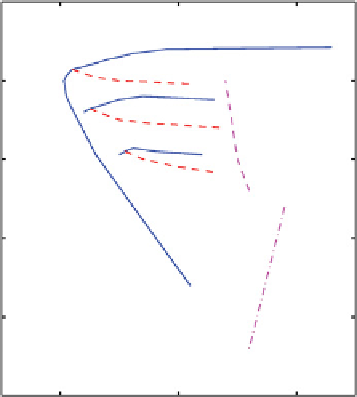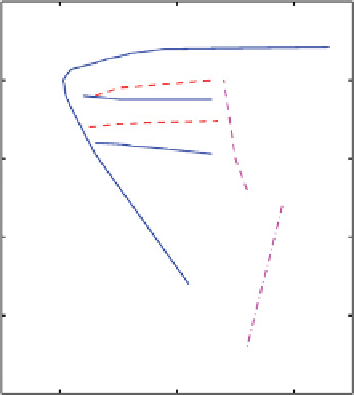Geoscience Reference
In-Depth Information
(a)
(b)
Upper axisymmetric
Upper axisymmetric
2AV
2S
2AV
2S
Structural
3S
Structural
3AV, 2S
3AV
3S, 2S
vacillation
vacillation
4AV, 3S, 2S
3S, 2S, 4S
2S
Lower
Lower
axisymmetric
axisymmetric
Irregular
Irregular
-2
)
log (Ta) or log (
E
-2
)
log (Ta) or log (
E
Figure 3.3.
Typical regime diagrams for flow regimes in the thermally driven baroclinic annulus; (a) filled with air (after
Castrejon-
Pita and Read
[2007],
Randriamampianina et al.
[2006], and
Read et al.
[2008]) and (b) filled with a water-glycerol fluid (after
Hide and Mason
[1975] and
Hignett
[1985]). The numbers refer to the dominant wave number and S indicates a steady wave
while AV indicates amplitude vacillations including complex vacillations such as MAV. Common ranges of the values explored
in such regime diagrams are
O(
10
−3
)
O(
1
)
and
O(
10
5
)
O
(
10
10
)
.
Ta
is a measure of the vertical stratification through a
ratio of the buoyancy term over the Coriolis term.
The term
thermal Rossby number
originates from the
standard Rossby number, Ro =
U/(fL)
, where the
scaling velocity is defined through the thermal wind bal-
ance
U
th
=
gαTd/(fL)
. The parameter is also related
to the stratification through the buoyancy frequency,
N
2
=
depend on other parameters as well, such as aspect ratios
and the Prandtl number. Common ranges of the values
explored in these regimes are
O(
10
−
3
)
O(
1
)
and
O(
10
5
)
O(
10
10
)
. Irrespective of precise val-
ues, a common observation is that amplitude vacillations,
including AV and MAV, are found within the parameter
space occupied by the regular and steady waves, whereas
the less regular structural vacillation types are found at
higher Taylor numbers or lower values of the dissipation
parameter as the flow moves toward turbulent flow.
The classic Reynolds number as the ratio of the dissi-
pation to the advection term is linked to the Taylor and
Rossby numbers through Re =
UL/ν
=
(U/fL)(fL
2
/ν)
=
Ro
/E
. Identifying the thermal Rossby number with the
Rossby number and Ta =
γ E
−
2
, the Reynolds number
can be written as Re =
√
Ta/γ
, and lines of constant
Reynolds number in Figure 3.3 are lines with a slope of
−
Ta
(∂ρ/∂z) g/ρ
(commonly also referred to as the
Brunt-Väisäla frequency), and by that to the rotational
Froude number
F
=
(fL/(Nd))
2
as
=4
/F
. In either
case, the thermal Rossby number is a measure of the ther-
mal forcing of the system whereas the Taylor number is a
measure of the dissipation. The mechanically driven two-
layer experiments tend to use the Rossby number defined
by the mechanically imposed velocity as one of the two
principal parameters and then either the Fr
o
ude number
−
or a dissipation parameter defined as
r
=
√
E/
Ro.
The flow observations can then be summarized in
regime diagrams in the parameter space defined by the two
parameters. While the illustrations of the regime diagrams
in Figure 3.3 were derived from the thermally driven annu-
lus, the equivalent regime diagrams for the mechanically
driven systems will show similar features and structures.
Since the regime diagrams intend to highlight the typi-
cal occurrence of amplitude vacillation-type flows, they
were compiled from a wide range of experimental obser-
vations across different systems and hence do not show
either more complex flows such as MAV flows or spe-
cific values of the nondimensional parameters since they
1
/
2 with low-Reynolds-number values in the lower left
corner and high Reynolds numbers in the upper right cor-
ner of the regime diagrams. Inserting the typical ranges
for
and Ta results in a typical range of the Reynolds
number as
O(
1
)
O(
5
)
. As will be seen later
in Section 3.3.5, equation (3.4), the Ekman or Taylor
number quantifies the dissipation through the Ekman lay-
ers, which is proportional to the potential vorticity. The
Reynolds number, on the other hand, quantifies the hor-
izontal viscous diffusion and is proportional to the sec-
ond derivative of the potential vorticity and hence highly
dependent on the length scales of the flow structures.
Re

















